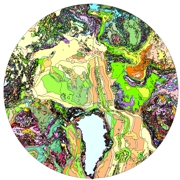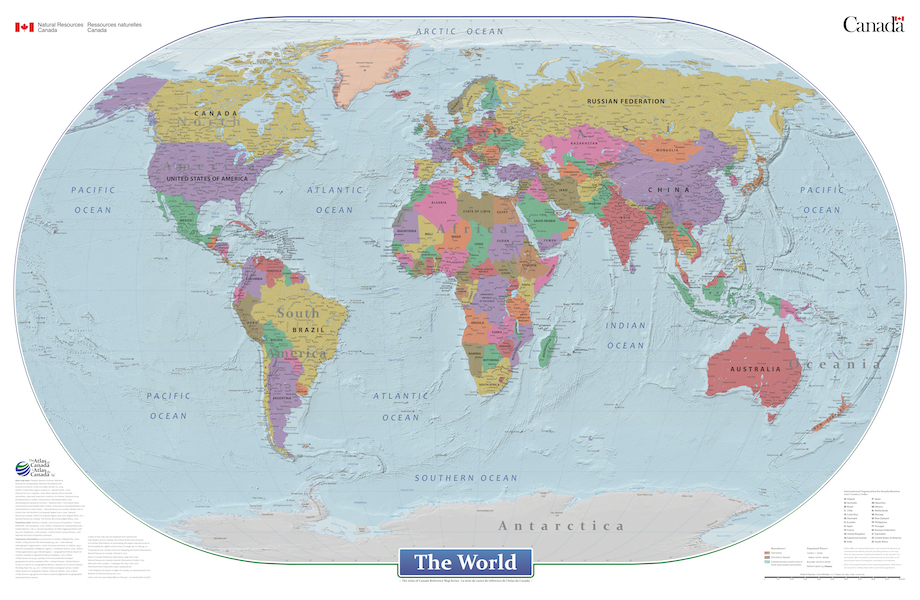FGDB/GDB
Type of resources
Available actions
Topics
Keywords
Contact for the resource
Provided by
Formats
Representation types
Update frequencies
status
Scale
Resolution
-
The Water Survey of Canada (WSC) is the national authority responsible for the collection, interpretation and dissemination of standardized water resource data and information in Canada. In partnership with the provinces, territories and other agencies, WSC operates over 2800 active hydrometric gauges across the country. WSC maintains and provides real-time and historic hydrometric data for some 8000 active and discontinued stations. This dataset consists of a set of polygons that represent the drainage areas of both active and discontinued discharge stations. Users are encouraged to report any errors using the “Contact Us” webpage at: https://weather.gc.ca/mainmenu/contact_us_e.html?site=water
-
Proxied dataset of inshore lobster commercial fishing for 2012 - 2021 in the Newfoundland and Labrador region. Only lobster harvested from the Newfoundland and Labrador region are included, based on species sought. Commercial data for the inshore lobster fishery does not require a set of coordinates be provided for catch records. With zero georeferenced inshore lobster records, the inshore lobster fishery leaves a major data gap in one of Newfoundland and Labradors largest fisheries. The Gulf region created a lobster proxy mapping tool, which associated each commercial lobster record with the most likely 10km2 hexagon grid cell based on a number of weighted variables. The tool was adopted by the Newfoundland and Labrador region and altered to work with its own variables which include human use, habitat, accessibility, area/location, home port distance, traditional ecological knowledge and depth. Each hexagon represents the summed total weight of all records associated with a particular hexagon. The best available commercial data used in this model is derived from landings data and may not include catches that have resulted in cash/wharf sales. As a result, there are some areas of Newfoundland and Labrador that may be under represented in this dataset where wharf sales may be high. Therefore, this dataset should be viewed as a general estimation on lobster harvesting patterns within Newfoundland and Labrador.
-

The Department of National Defence has designated Firing Practice and Exercise Areas off the coasts of Canada. Activities in these areas may include bombing practice from aircraft, air-to-air, air-to-sea or ground firing, and anti-aircraft firing, etc. In Atlantic Canada, the Nova Scotia Area includes sea area employments for sub-surface operations and firing exercises (FIREX). The Gulf of St. Lawrence Area, excluding the French territorial waters of Saint-Pierre et Miquelon, includes sea area employments for sub-surface operations and underwater demolition training. For full details, see the Notices to Mariners, Section F, National Defence Military Notices, available online: https://www.notmar.gc.ca/publications/annual-annuel/section-f/f35-en.pdf. Legal Constraints: Users should be aware that the polygons depicting firing practice and exercise areas are intended for illustration only and should not be used for navigational or legal purposes.
-

The water level data comes from the groundwater monitoring network of Saskatchewan (Canadian province). Each well in the observation network is equipped with a hydrostatic pressure transducer and a temperature sensor connected to a data logger. A second pressure transducer located above the water surface allows for adjusting the water level according to atmospheric pressure variations. The time series refers to the level below which the soil is saturated with water at the site and at the time indicated. The water level is expressed in meters above sea level (MASL). The dataset consists of a general description of the observation site including; the identifier, the name, the location, the elevation and a series of numerical values designating the water levels at a defined date and time of measurement.
-

As part of the International Polar Year (IPY) 2007'08 and 2008'09 activities, and related objectives of the Commission for the Geological Map of the World (CGMW), nations of the circumpolar Arctic have co-operated to produce a new bedrock geology map and related digital map database at a scale of 1:5 000 000. The map, released in north polar stereographic projection using the World Geodetic System (WGS) 84 datum, includes complete geological and physiographic coverage of all onshore and offshore bedrock areas north of latitude 60° north.
-

It has long been understood that eelgrass (Zostera marina) is important to waterfowl such as Atlantic Brant (Branta bernicla hrota), Canada Goose (Branta canadensis), American Black Duck (Anas rubripes), Common Goldeneye (Bucephala clangula) and Barrow's Goldeneye (Bucephala islandica). In New Brunswick, eelgrass can be found along the Gulf of St. Lawrence, in protected harbours such as at Neguac Bay, in the province's northeast (47015’N, 65002’W).This dataset contains results from an eelgrass classification for Neguac Bay, New Brunswick. True colour aerial photography at 57 centimetre resolution was collected on September 2, 2009 by Nortek Resources of Thorburn, Nova Scotia (https://www.nortekresources.com/). Image classification was conducted using eCognition Developer v. 8 Software, which first segments the image into spectrally similar units, which were then classified manually. Additionally, the Department of Fisheries and Oceans (Gulf Region, Moncton, NB) conducted a visual field survey in the same field season at 126 sites. Two-thirds of these sites were used to assist in image classification, while the remainder were used to assess accuracy. Three classes were identified:Good Quality Eelgrass: relatively dense, clean, green blades with minimal epiphytes or algal growth. Medium Quality Eelgrass: predominately green blades that may have some epiphyte or algal growth. These stands can be less or equally dense as Good Quality Eelgrass, but the best grasses are certainly not as abundant. Eelgrass Absent/Poor Quality: eelgrass is absent, or if it is present it is typically covered with epiphytes or other algae or dying or dead. Eelgrass was classified correctly 81% of the time in a fuzzy accuracy assessment technique, whereby those classes that were ‘off’ by one class, e.g. Good Quality eelgrass classed as Medium Quality, were given half credit towards the overall accuracy. Of 39 sites that were within the classification area, 27 were correct, 9 were "one-off", and 3 were incorrect [(27 + (9/2))/ 39 = 0.81].
-
This dataset provides geospatial polygon boundaries for marine bivalve shellfish harvest area classification in Canada (British Columbia, New Brunswick, Newfoundland and Labrador, Nova Scotia, Prince Edward Island and Quebec). These data represent the five classification categories of marine bivalve shellfish harvest areas (Approved; Conditionally Approved; Restricted; Conditionally Restricted; and Prohibited) under the Canadian Shellfish Sanitation Program (CSSP). Data are collected by Environment and Climate Change Canada (ECCC) for the purpose of making applicable classification recommendations based on pollution source assessment and water quality survey results. ECCC recommendations are reviewed and adopted by Regional Interdepartmental Shellfish Committees prior to regulatory implementation by Fisheries and Oceans Canada (DFO). These geographic data are for illustrative purposes only; they show shellfish harvest area classifications that may be superseded at any time by regulatory orders issued by DFO, which place areas in Closed Status, due to conditions such as sewage overflows or elevated biotoxin levels. For further information about the current status and boundary coordinates for areas under Prohibition Order, please contact your local DFO office.
-

This cartographic digital product is derived from the Atlas of Canada's wall map "The World" (MCR 0046) and "Le monde" (MCR 0046F) published in 2021. The World is a general reference political map focused on the names and international boundaries of sovereign and non-sovereign countries. The information is portrayed using the Winkel II projection at a scale of 1:29 000 000. The dataset includes international boundaries, populated places, and labelled major hydrographic and physical features. In the geodatabase the representation of political boundaries do not necessarily reflect the position of the Government of Canada on all international issues of recognition, sovereignty or jurisdiction; some of the populated places have seasonal populations, while others are research or military bases with no permanent populations; and, there are no attribute information in the geodatabase for the labelled hydrographic and physical features.
-
Three marine spatial planning areas are delineated in Eastern Canada to define the spatial extents of marine spatial plans being led by Fisheries and Oceans Canada (DFO): the Estuary and Gulf of St. Lawrence (EGSL), the Newfoundland and Labrador (NL) Shelves, and the Scotian Shelf and Bay of Fundy. The EGSL planning area includes the St. Lawrence River estuary from northeast of Île d’Orléans, Quebec, the Saguenay River estuary, and the entire Gulf of St. Lawrence as far north as the Strait of Belle Isle (NAFO Divisions 4RST). The NL Shelves planning area includes areas off southern, eastern and northern Newfoundland, part of the Churchill River and Lake Melville, as well as off the Labrador coast to the extent of the exclusive economic zone (EEZ) (NAFO Divisions 2GHJ and 3KLNOP). The Scotian Shelf and Bay of Fundy planning area includes DFO Maritimes’ administrative region off the Atlantic coast of Nova Scotia to the extent of the EEZ, the Bay of Fundy and the Canadian portion of the Gulf of Maine (NAFO Divisions 4VWX, 5Ze, and the Canadian portion of 5Y). The French EEZ for St. Pierre et Miquelon is excluded from the three planning areas. These planning areas are derived from Federal Marine Bioregions (https://open.canada.ca/data/en/dataset/23eb8b56-dac8-4efc-be7c-b8fa11ba62e9) that were developed by a Canadian Science Advisory Secretariat process using ecosystem-based management principles to define 13 ecological bioregions that have informed but not directed DFO implementation of marine spatial planning.
-

This dataset provides marine bacteriological water quality data for bivalve shellfish harvest areas in Prince Edward Island, Canada. Shellfish harvest area water temperature and salinity data are also provided as adjuncts to the interpretation of fecal coliform density data. The latter is the indicator of fecal matter contamination monitored annually by Environment and Climate Change Canada (ECCC) within the framework of the Canadian Shellfish Sanitation Program (CSSP). The geospatial positions of the sampling sites are also provided. These data are collected by ECCC for the purpose of making recommendations on the classification of shellfish harvest area waters. ECCC recommendations are reviewed and adopted by Regional Interdepartmental Shellfish Committees prior to regulatory implementation by Fisheries and Oceans Canada (DFO). This dataset is 'Deprecated'. Please use updated source here. https://open.canada.ca/data/en/dataset/6417332a-7f37-49bd-8be9-ce0402deed2a
 Arctic SDI catalogue
Arctic SDI catalogue